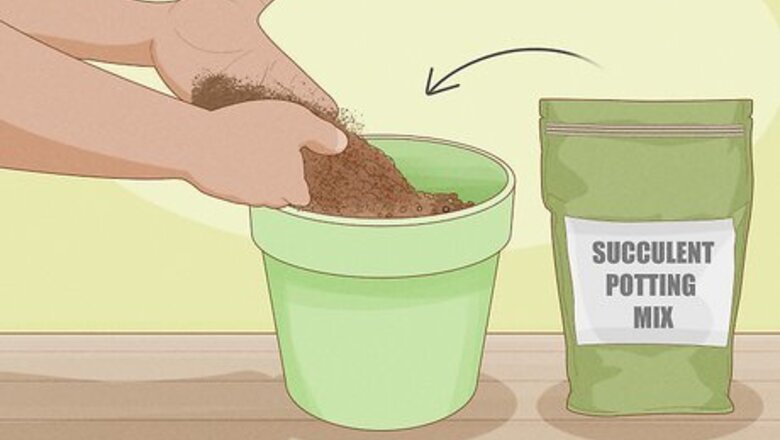
views
How to Plant a Jade Plant
Choose a wide and sturdy pot to plant the jade in. Take an existing jade plant and choose a large, sturdy pot for it to grow comfortably in. Fortunately, these plants only require a little space. So, a 4 to 6 in (10 to 15 cm) pot with adequate drainage holes is sufficient.
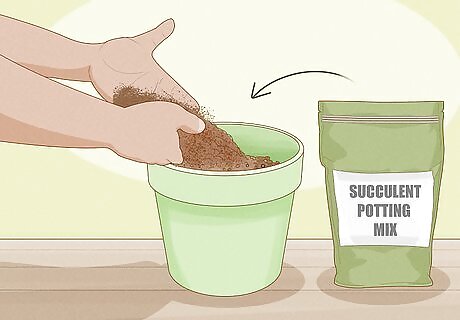
Combine potting soil mix and perlite to fill the pot with. Regular soil potting is too heavy for jade plants to root and drain easily. Too much water can cause the plant to die. Instead, purchase a pre-made succulent or cacti potting mix or combine 2 parts of potting soil, perlite, and sand to make your own. If you are worried about your plant draining well enough, use a clay pot instead of a plastic pot. Ensure there is a drainage hole on the bottom where water can escape. Dump out any excess water in the saucer beneath the pot.

Place the jade in the soil and allow it to sit for a week before watering. Use your hand or a trowel to make a hole slightly larger than the roots of the jade plant to sit into. Place the roots deep enough so the plant can stand up independently. Pack the soil loosely around the roots until the plant feels secure.
Propagating a Jade Cutting in Soil

Remove a 3 to 5 in (7.6 to 12.7 cm) stem from an established plant. If you already have a large jade plant or know someone who does, take a sharp knife or clippers and choose a thick stem with healthy leaves. Leave a few inches of space between the bottom of the stem and the leaves. Follow the same process if you’re using a complete jade leaf instead of a cutting.
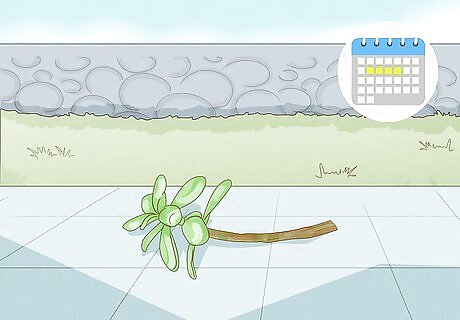
Allow the cutting to dry for a few days. Giving the cutting a few days to dry out and scab over will help keep your little jade plant healthy while it is rooting. All you have to do is leave the cutting on a clean paper towel and wait until the stem is dry or scabbed over. The larger the cutting, the more time this will take. It will also take longer if you do this in the winter instead of during the warm summer months.
Plant the cuttings vertically in pre-moistened potting soil. Fill a container with adequate drainage with soil made specifically for succulent plants. Then, make a hole in the soil with your finger and gently place the stem in. Lightly pack the soil around the base of the cutting to keep it in place. Alternatively, mix your soil with equal parts sand, perlite, and compost. Add a rooting hormone to help cuttings grow more successfully. However, this is optional.
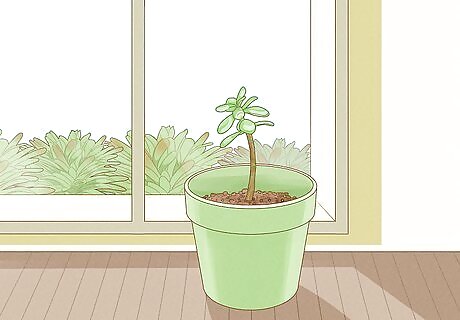
Move the pot to a sunny window and wait for it to grow. Plant Specialist Melinda Meservy recommends placing the plant in a sunny spot away from direct sunlight so the leaves don't burn. In three to four weeks, you should notice new growth on top of the plant. This is a good sign that your plant has successfully rooted. Avoid the temptation to water your plant while it is rooting. This will increase the chance that the stem will rot and kill your rooting plant altogether. Once your jade plant has rooted, you can consider moving it to a larger pot if you want to. If your plant isn't rooting, and it's only been a few weeks, try waiting a bit longer. Succulent plants root easily, so it's a possibility the plant didn't have enough time to root. Alternatively, gently remove the cutting from the pot to see if the roots are growing. Don't do this too often, though, as it only slows the process.
Propagating a Jade Cutting in Water
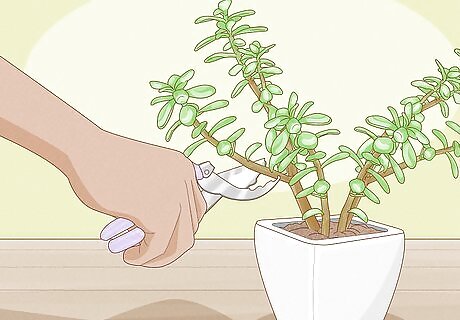
Cut a 3 to 5 in (7.6 to 12.7 cm) stem from an established plant. Use a sharp knife or clippers on an established jade plant and choose a thick stem with healthy leaves. Leave a few inches of space between the bottom of the stem and the leaves. Using dirty tools can spread disease to the plant.
Place a dry cut in a clear propagation jar with 1 in (2.5 cm) of water. If leaves are growing down the stem, remove them with pruning clippers so the roots can grow properly. Place the stem in indirect light for a few days to heal the cut. This will prevent the root from water in water. Fill a container with 1 in (2.5 cm) of water, ensuring the leaves are 2 to 3 in (5.1 to 7.6 cm) above water.
Move the cutting into bright, indirect light for 4 to 5 weeks. Let the plant cutting rest in water and move the container into a place where it can receive plenty of filtered light for a few weeks. During this time, monitor the roots, looking for visible, clean roots. Change the water once a week to encourage growth. After this point, you can transfer the cuttings to the soil.
How to Care for Jade Plants

Position the plant to get 6 hours of bright, indirect light daily. While a jade plant needs a lot of sunlight, it doesn't need to be in full sun for the entire day. Instead, move your plant in stages. For instance, if you've kept your jade in a shadowy corner, move the plant to an area with an hour of indirect sunshine. This will help the plant adjust so the leaves don't burn and fall off. Do this for a few days before moving it to an area with more sunshine.
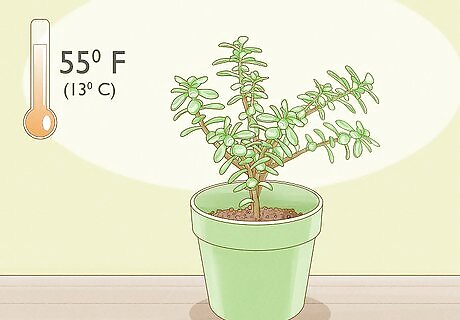
Maintain a temperature of 65 to 75 °F (18 to 24 °C) during the day. As tropical plants, jades prefer warmer temperatures. They thrive under direct sunlight. However, south-facing windows should be avoided to prevent wilting or sun-bleaching of the leaves because that’s where they’ll be most exposed to the sun. During the night, temperatures should be between 50 to 55 °F (10 to 13 °C). When winter hits, move your plants indoors (if they’re outside) and keep them away from the windows. Jade plants hate the cold, and their leaves may drop due to drafty windows.
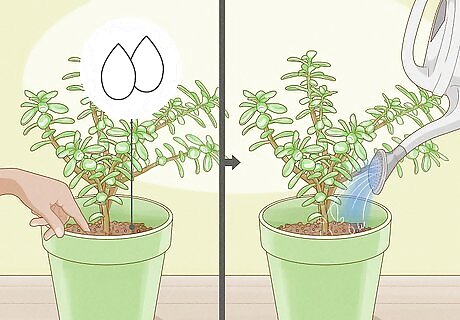
Let the soil dry out partially between waterings. As succulents, jade plants don’t require daily water. In fact, you should let the soil get partially dry before adding more. Overwatering can cause it to rot. Dig a finger into the soil to test if it’s dry. If it is, add water. If it’s still moist, save it for another day. During the winter, your plant will likely need even less watering than normal, so always check the soil. Many people recommend watering succulents by soaking the entire pot in a tub to soak up the water from the bottom. However, you can also water the plant by pouring water into the pot through the top. The most important thing is allowing the excess water to drain completely from the pot. Do not leave the jade plant sitting in water. If you notice excess water, empty it from the saucer. Try to avoid getting the leaves wet when watering.
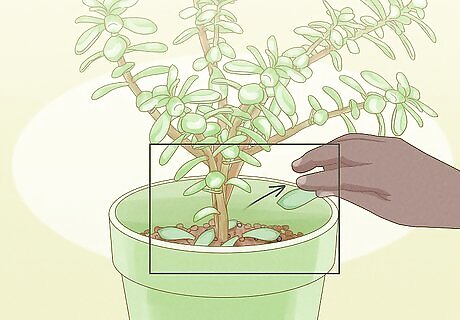
Prune during the spring and early summer to keep it healthy. If any leaves have fallen off the tree into the pot, remove them. Prune your plant once a year using clippers to cut off the leaves, leaving a few inches to avoid messing with the main stem. If you cut into the main stem, you may kill the plant. Cutting off new growth will help the plant stay more bush-like and less spindly.
Add half a dose of strength fertilizer to encourage growth. Unlike other plants requiring feeding, jade plants are sensitive to overfertilizing. So, you should only add fertilizer if you feel your plant has stopped growing or doesn't perform as well as it used to. For instance, there's less growth or more wilted leaves. Apply a half-dose strength fertilizer to the soil and wait to see if growth resumes.
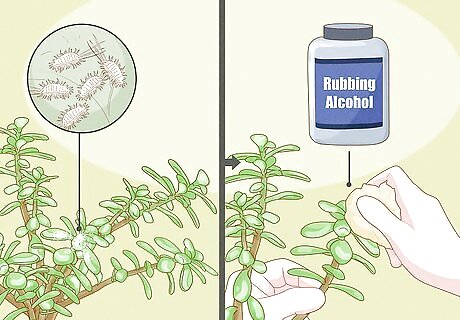
Apply rubbing alcohol to the leaves to prevent pests. It is not a common problem, but jade plants can become infested with bugs. If you notice a problem with small mealybugs on your plant, use a bit of rubbing alcohol and a cotton swab to wipe down the leaves of your plant gently. When looking for bugs, look for small, fluffy, white deposits on the leaves. These are a sign that there are bugs. Additionally, you can use a magnifying glass to identify red spiders, which are too small to see with the naked eye. Avoid using an insecticidal soap on your plant as this may damage the leaves. Plant Specialist Melinda Meservy says bugs can indicate your plant is unwell. Getting your plant healthy again will usually prevent pests.

Wipe the leaves with a damp cloth to keep them clean. Some users recommend gently removing dust with a soft cloth and water if your plant is dusty. Alternatively, if it is a rainy day, it is okay to place the plant outside, which will help rinse off the dust. Make sure the leaves can dry out completely if they get wet. A plant with water left on the leaves may rot or grow mildew.
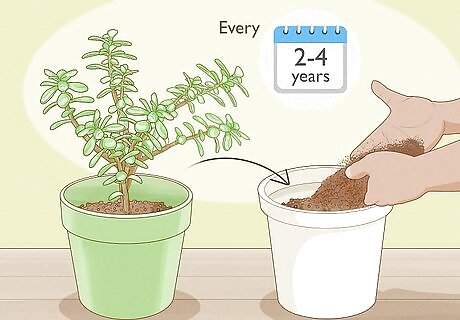
Change the soil every two to four years. Though you can leave the plant in the same pot for many years, as long as you are not overwatering it, changing the soil with fresh, pre-made succulent potting soil every two to four years will allow you to inspect the roots for any damage or rot. Additionally, giving the plant some fresh, dry soil will make sure the plant continues to flourish. If you notice that a Jade plant you've had for many years is not doing well, replanting it may help it spring back.
When to Repot a Jade Plants
Repot jade plants every 2 to 3 years during the spring to encourage growth. Repotting is optional for growing jade plants, as they can thrive in the same spot for several years. However, repotting every two to three years is sufficient during its early life stages. Four years or more is safe for mature plants, so long as it's done in early to mid-spring so the plant can recover successfully. Jade plants can live for 50 to 100 years when taken care of properly. To repot a jade plant, carefully pull the plant from its current pot, taking care not to damage the leaves. Loosen the roots and lower the plants into a new pot onto a layer of soil. Fill in the gaps with additional soil. Wait one week before watering.
Common Problems with Jade Plants
Shrived or wrinkled leaves Jade leaves are known for their beautiful green leaves. So, if the edges look shriveled, wrinkled, or begin to droop, this is a sign of underwatering. Use your finger to check the soil and add more water to see if that helps.
Drooping leaves When your jade plant looks sad, this could be a sign of stress. This can be caused by under or overwatering, lack of sunlight or drastic temperature drops. Use your finger to inspect the soil. Then, survey the area where the jade plant is sitting. Does it get at least 6 hours of sunlight? If not, try a different spot. Use a thermometer to gauge the temperature. Use a heat mat to warm the plant if it's too low. If it’s too low, try moving it to an area with indirect sunlight.
Different colored leaves A plant’s leaf colors can tell you a lot, such as if it’s being burnt by the sun or not getting enough nutrients. Take a look at some of these leaf colors to figure out the problem: Yellow Leaves: Overwatered or nutrient deficient. Black Leaves: Excessive moisture or pest and disease problems. Brown Leaves: Excessive moisture, underwater, or excessive sunlight. Brown Spots: Trauma, such as physical damage or improper pruning. Red Leaves: Excessive sunlight or minor stress. White Spots: Salt deposits are left behind from moisture evaporation; wipe them off with a damp cloth. White Fluff: Pest infestation, specifically mealybugs.
Lack of new growth While jade plants are slow growers, if you notice it’s not growing at all, this may be a sign that it needs repotting or additional fertilizer. Similarly, a lack of sunlight can contribute to the problem too.
Stretched stems The stems of jade plants are notorious for being solid, thick, and strong. But, if it’s gone limp or stretchy this is a sign that your plant is in a low-light area and its limbs are stretching towards the nearest light source.
No flowers Jade plants are more likely to bloom when planted outdoors. However, if you want your indoor jade plant to flower, ensure they have adequate sunlight and keep the plant root-bound to avoid stress. Adjust your indoor temperatures to mimic the temperature drop outside to encourage the plant to blossom.












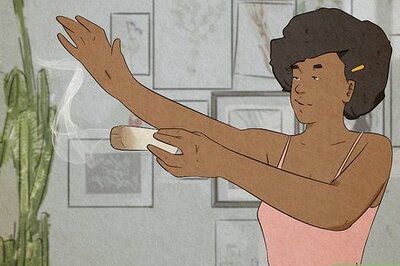





Comments
0 comment